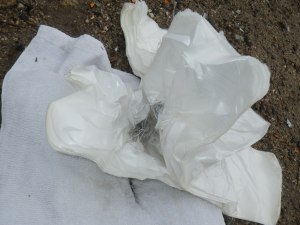In several of my posts, I mention that while UHMWPE UD armor is an excellent choice for certain applications, and has material advantages over woven or laminate Aramid ballistic fabrics (higher potential V50, positive buoyancy, UV resistant, waterproof), it suffers from several glaring weaknesses (degrades to complete ineffectiveness above 170F, no breathability, delaminates/curls, and is WEAK AGAINST CONTACT SHOTS).
It is important to reiterate that last weakness: a large number (if not the majority) of self-defense and duty scenarios take place at 0-5 feet, where contact shots are a high likelihood. Woven Kevlar soft armor has shown to provide EXTREMELY good protection against contact shots (defined as the muzzle of the weapon being in physical contact with the vest or armor panel). The point at which Kevlar chars is around 500F, and it will retain its strength below this temperature.
The failure mechanism for UHMWPE in contact shots is the high temperature propellant gases that exit the muzzle microseconds after the bullet. These gases heat the area surrounding the muzzle and bullet path, and cause the laminate to melt/denature. This allows the bullet to penetrate much further than would normally be possible. In the case of large caliber revolvers (with a large muzzle blast footprint), this can allow the round to completely defeat the vest.
For the sake of the test, the round chosen was the .357 Magnum, rather than a .44 Magnum, as I wanted to see if the (relatively!) more modest caliber would still defeat the level II ballistic panel. The panel consisted of 15 layers of Dyneema SB-38. Round chosen was Hornady Custom 158 gr. XTP @ 1250 fps muzzle velocity, from 6″ barrel. The level II panel is specced to stop an equivalent round.
The panel was placed against a backing material consisting of 8 layers of bubble wrap, covered in a dish towel. In retrospect, this was probably a bit too “springy,” giving the panel an advantage by permitting it to move away from the hot muzzle blast faster than if the armor was being worn.
The test panel and backing were placed upon the ground, and the muzzle pressed firmly (but not forcefully) against the surface. The round was discharged into the center of the panel.
The panel was defeated, showing that the muzzle blast had melted a moderately large area around the point of contact. The round penetrated the backing and buried itself into the dirt (as shown).
To verify, a second round was fired into the lower left area of the panel (away from the heat affected zone of the first round). The second round performed identically, burying itself into the dirt beneath the panel.
Conclusions:
The results of the test shows that UD UHMWPE laminates are at risk vs. contact shots. Heat from the muzzle gases (especially medium to large caliber revolvers) “blazes a trail” so to speak, for the round to penetrate further than it normally would.











